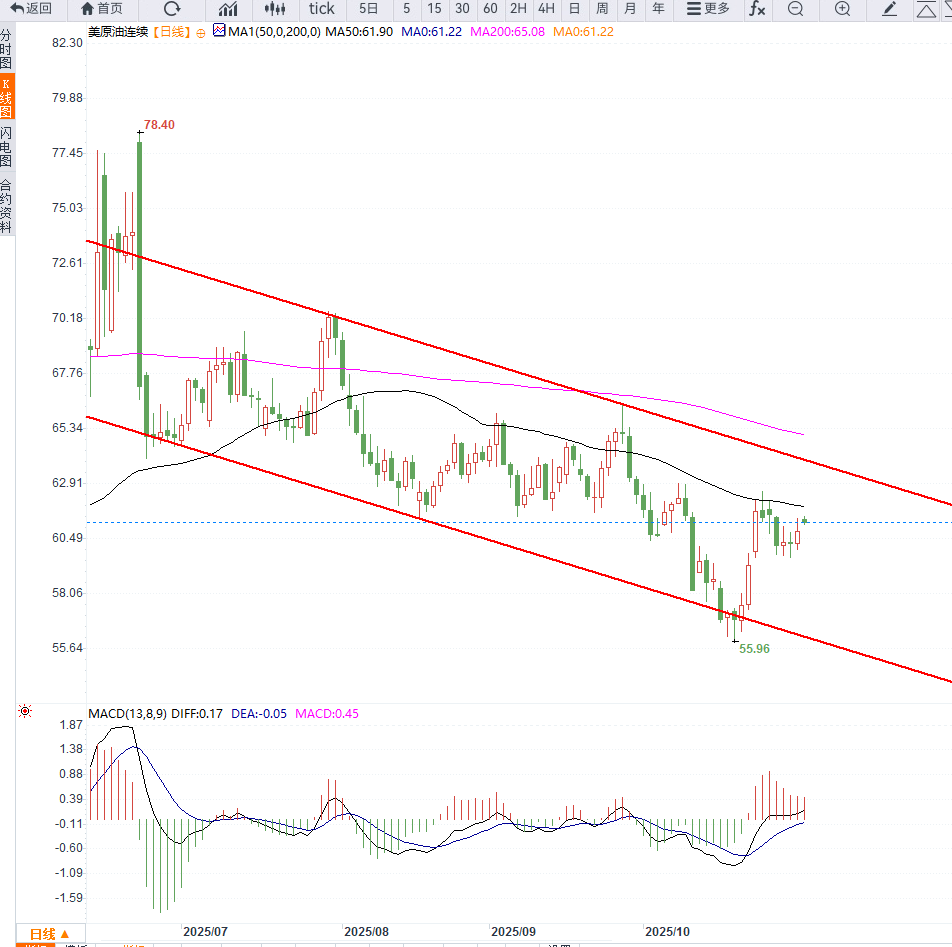Crude oil trading alert: Oversupply concerns limit oil price gains; short-term price action is expected to remain range-bound.
2025-11-03 10:05:44
However, last week's US Treasury sanctions against Russia's Rosneft and Lukoil have prompted the market to reassess the supply and demand outlook. Currently, the global crude oil surplus remains around 1.9 million barrels per day. Although supply still exceeds demand, the rate of surplus growth may slow in the future, thus providing some support for oil prices.
Jim Burkhard, Vice President of S&P Global , pointed out: "From a fundamental perspective, demand remains healthy, but the market is facing a wave of 'oil seeking its home'."
 Market research shows that Asian countries continue to expand their crude oil reserves, especially by actively stockpiling oil beyond their domestic consumption needs, which "absorbs a large amount of excess supply that could have previously driven down prices."
Market research shows that Asian countries continue to expand their crude oil reserves, especially by actively stockpiling oil beyond their domestic consumption needs, which "absorbs a large amount of excess supply that could have previously driven down prices."Meanwhile, consumption in the Middle East remained robust, while India increased its imports due to lower Russian oil prices, creating a new demand support. Mizuho energy analyst Nitin Kumar stated, "Although the market remains in a state of surplus, strong buying from Asia is helping to balance supply and demand."
Over the past six months, OPEC+ has continuously raised its production targets, with the most recent increase being 137,000 barrels per day. Global oil tanker storage is currently approaching 1.4 billion barrels, marking a ten-week consecutive increase.
Despite Asian countries' efforts to expand oil storage facilities, their capacity to absorb crude oil is limited, forcing some to remain at sea and increasing transportation and storage costs. On October 22, the U.S. Treasury Department announced sanctions against Rosneft and Lukoil, whose combined exports amount to approximately 3 million barrels per day.
This move caused significant volatility in the crude oil market, with Brent crude and WTI futures rising more than 5% in a single week, the largest increase since June. Goldman Sachs' analysis team predicts that if the impact of the sanctions is limited, global supply will decrease by approximately 500,000 to 600,000 barrels per day, and oil prices may fall to $56 for Brent and $52 for WTI, respectively.
From a technical perspective, the WTI crude oil daily chart shows that prices have been consolidating within a rectangular range over the past three months, between approximately $57 and $63. The short-term moving average (9-day EMA) has crossed above the medium-term moving average (21-day EMA), indicating strengthening short-term buying pressure.
The Relative Strength Index (RSI) remained above 50 on the 14th, suggesting strong market momentum but not yet entering overbought territory. If prices can firmly break through the $63 resistance level, the upside target will be the $67-$70 range.
Conversely, if the price breaks below the $58 support level, it may retest the year's low of $55. Overall, the technical structure suggests a mild rebound, reflecting that the market is still digesting the uncertainty surrounding the impact of sanctions.
Mizuho analyst Kumar said, "Although inventory accumulation has finally occurred, this surplus may be short-lived." According to a survey by the Kansas City Federal Reserve, the break-even point for U.S. oil companies is $63 per barrel, while the oil price threshold to stimulate drilling is about $78 per barrel.
Currently, WTI crude oil is trading around $60, still some distance from its profit target, which will limit further expansion of US shale oil production capacity and indirectly support market prices. From a fundamental perspective, the market is not in a state of complete imbalance, but geopolitical risks make future oil price movements highly uncertain.

Editor's Viewpoint: The oil market is currently at a crossroads between fear and fundamentals. While US sanctions may push up oil prices in the short term, continued production increases by OPEC+ and a slowdown in demand recovery will challenge price support. The market's next move may depend on whether confidence can be rebuilt.
- Risk Warning and Disclaimer
- The market involves risk, and trading may not be suitable for all investors. This article is for reference only and does not constitute personal investment advice, nor does it take into account certain users’ specific investment objectives, financial situation, or other needs. Any investment decisions made based on this information are at your own risk.





















